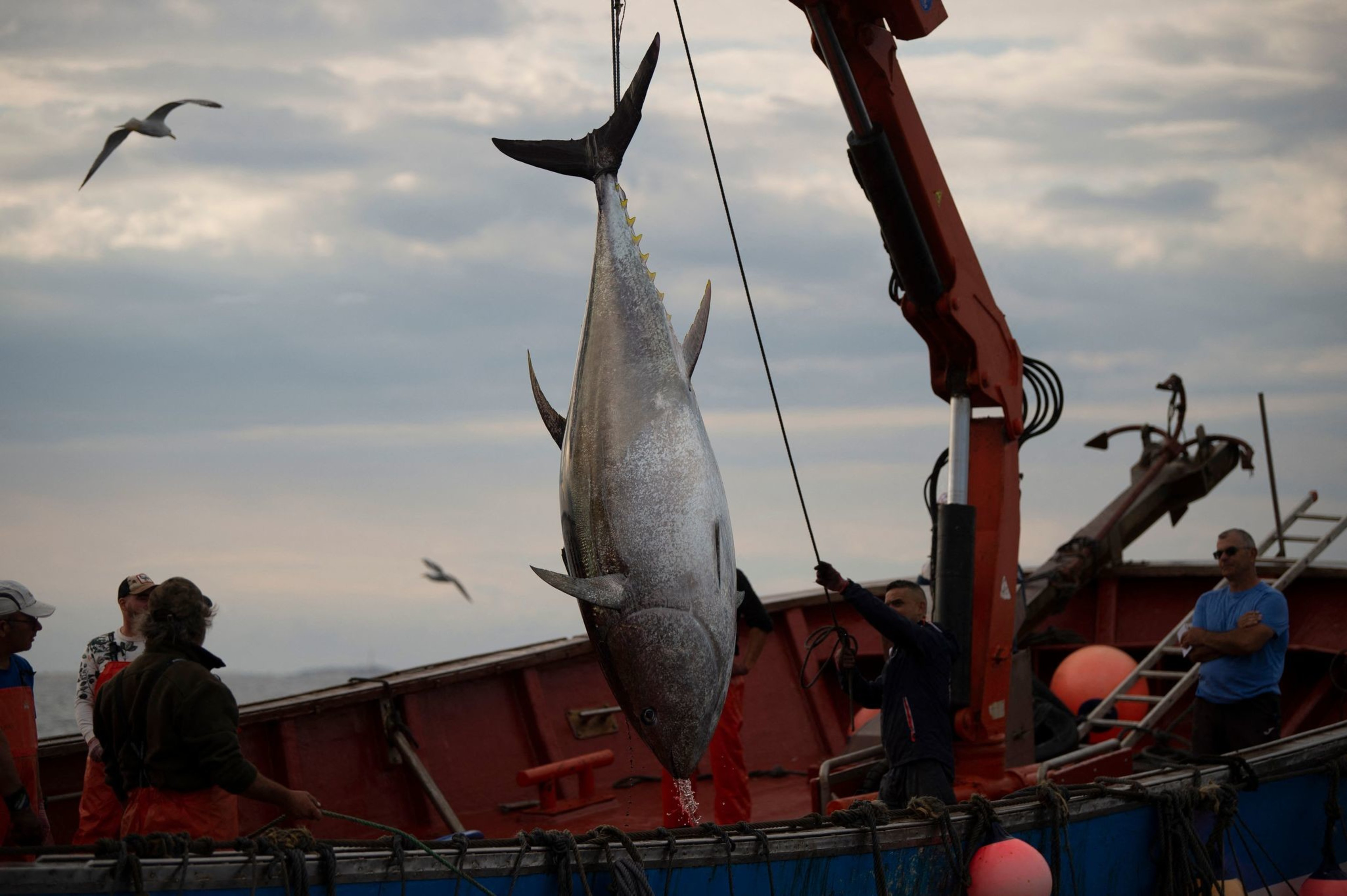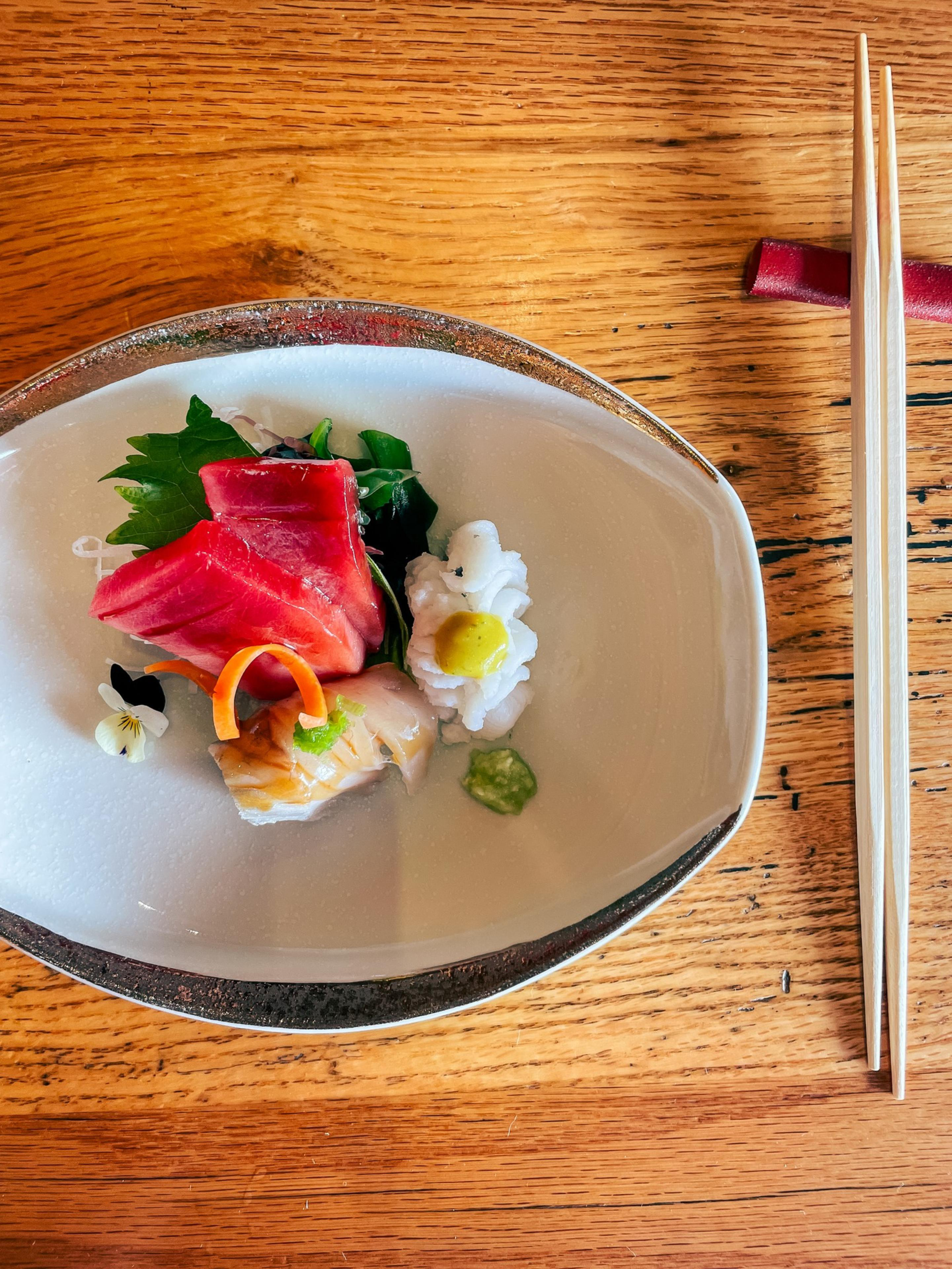Some lovers of Japanese food worship at the altar of wagyu. Others bow down to buttery uni. But for many, it’s all about bluefin tuna.
“When people love bluefin, they love bluefin,” says chef Jiro Lin of Hamano, a sushi restaurant in Noe Valley. “When they put the piece in their mouth, their face is glowing.”
Aged, cured, or marinated; blowtorched, dolloped with caviar or dotted with gold leaf—a piece of fatty tuna makes for one single, outrageously luxurious bite.
It’s hard to believe this massive fish, often weighing in the hundreds of pounds, was once sold for pet food, before diners developed a taste for it in the 1950s. Today, it has grown to mythological proportions: What a thrill to watch a former sushi chef catch a beast of a bluefin (opens in new tab) near our own bay. Or learn that one sold for nearly $800,000 (opens in new tab) at the Tokyo auction in January, and another went for over $3 million (opens in new tab) in 2019. It’s impossible not to be transfixed by a video of a Japanese omakase master breaking down a whole tuna (opens in new tab)—cracking open the rich cheeks and scraping the sweet bones.
But it’s a cold hard fact: Bluefin is not a sustainable choice. The Monterey Bay Aquarium Seafood Watch firmly places bluefin tuna in the red category to “avoid.” That includes all three types—Pacific (opens in new tab), Atlantic (opens in new tab), or Southern (opens in new tab)—both wild and farmed. Overfishing has decimated populations, and in 2010, Pacific bluefin bottomed out at 1.5% of the historic population level.


Thanks to an international agreement made by Pacific fisheries in 2017 (opens in new tab), it has recovered slightly and was up to 10% by 2020 (opens in new tab). And while some farms are working toward responsibly raising bluefin, many sustainability experts aren’t yet convinced by their practices.
Unfortunately, the Seafood Watch recommends not eating this fish, at least for now. “We’re optimistic. We’re seeing improvement. There’s a chance that some of our ratings [for wild bluefin] could move out of the red,” says Corbett Nash, an outreach manager with Seafood Watch. “But we’re not quite ready to declare that yet.”
Yet despite biologists’ warnings, bluefin is swimming across high-end menus all over sushi-mad San Francisco, where it’s often served as the piece de resistance. Flipping through a dozen of the city’s finest sushi menu, every single one proudly serves bluefin and highlights it as a star of the show. In a city full of chefs and diners devoted to local and seasonal produce and regenerative beef, somehow we seem to have a blindspot for bluefin.
Admittedly, diners might be genuinely confused about whether they’re eating bluefin or not. It goes by many other Japanese names, depending on the specific cut. In broad strokes, maguro is the general term for tuna, while hon maguro, or “true” tuna, refers to bluefin. Akami is lean and dark red from the top of the fish near the spine, chutoro is medium fatty and rosy from the side, and otoro is the most fatty and marbled from the deep belly.


Snag one of only seven seats at Ken in the Lower Haight, and bluefin in all its forms stars across the omakase menu ($225 per person). Chef Ken Ngai sources farmed bluefin from Japan, swaddles each hunk in papers, and changes them out often, to fastidiously age the fish for a couple of weeks. “It’s almost like a baby,” Ngai says. “Every day you have to check and change the fish diaper.”
He slices the lean akami as pristine sashimi. He marinates the medium chutoro in soy and sake, in the style of his chef mentor Mitsunori Kusakabe, who loves this undersung cut. He blasts the ultra-fatty otoro with a blowtorch, so it picks up caramelized edges and smoky aromas. Finally, he chops every last scrap into a handroll with pickled radish and chives. Do diners ever ask about sustainability? Not particularly, the chef says. They simply moan when they take a bite.
At Hamano, bluefin also comes a la carte. Chef Jiro Lin mostly sources it farmed from Spain and—somewhat reluctantly—admits that he occasionally gets small quantities of wild bluefin from Japan. “When you go to Japan, a good sushi restaurant has to have good tuna,” Lin says. “Tuna is the king of sushi.”
But the chef says he tries to minimize bluefin and balance it with other choices. He uses bigeye tuna from Hawaii for the spicy tuna rolls and albacore tuna in several others. Lin says one time, a Michelin-starred chef did give him grief for serving bluefin, which he took to heart. But the fans still demand it, often swinging through the door, calling “toro!”


Nearly all San Francisco chefs contacted for this story say that the bluefin they’re serving is farmed rather than wild. Ju-Ni and Omakase source their farmed fish from Japan, Sushi Hon pulls from Spain, and Akikos and Wako order from Baja, Mexico. Many of the farms these restaurants patronize claim to use sustainable practices—and clearly chefs want to believe it.
There are a couple of recognized sustainable farming methods, including raising the fish all the way from eggs (opens in new tab), or capturing babies and finishing them in ocean pens (opens in new tab), huge round fences floating on open water, with giant, torpedo-shaped fish swirling below the surface. But as a predatory and migratory fish that swims constantly in the wild, bluefins require a huge amount of feed to fatten up, and those babies might still come from exploited stocks.
One restaurant that doesn’t use farmed bluefin is Hashiri (opens in new tab), in Mint Plaza, which proudly showcases wild bluefin from Shiogama, Japan. Notably, there are a couple of restaurants in the Bay Area that decline to put bluefin on the menu whatsoever: It’s nowhere to be seen at Tataki, the small sustainable sushi bar in Pacific Heights. Or at Bamboo Sushi, the big sustainable sushi chain from Portland, Oregon, which originally planned to open a location on the Embarcadero, but instead focused on San Ramon.
For sustainable alternatives, there are certainly other types of tuna in the sea. Both bigeye tuna (opens in new tab) and albacore tuna (opens in new tab) can be great choices, although, of course, albacore is much lighter in flavor and texture. For fatty fish, king salmon (opens in new tab) or arctic char (opens in new tab), with their rich marbling, might satisfy the craving. And despite the confusion, hamachi, aka yellowtail (opens in new tab), is a “best choice” according to the Seafood Watch, despite how wildly popular it is in both sushi and crudo.
So what’s a bluefin lover to do? Speaking personally, I certainly won’t be ordering it recklessly for Friday night takeout, especially if there’s nice albacore to be had. I sincerely don’t know how to feel about the ethics of indulging on a special occasion. But I think the first step is simply acknowledging that we’d like bluefin to be here for the long haul. Our ability to resist the lure of that melt-in-your-mouth otoro just might affect the future of this mighty fish.

